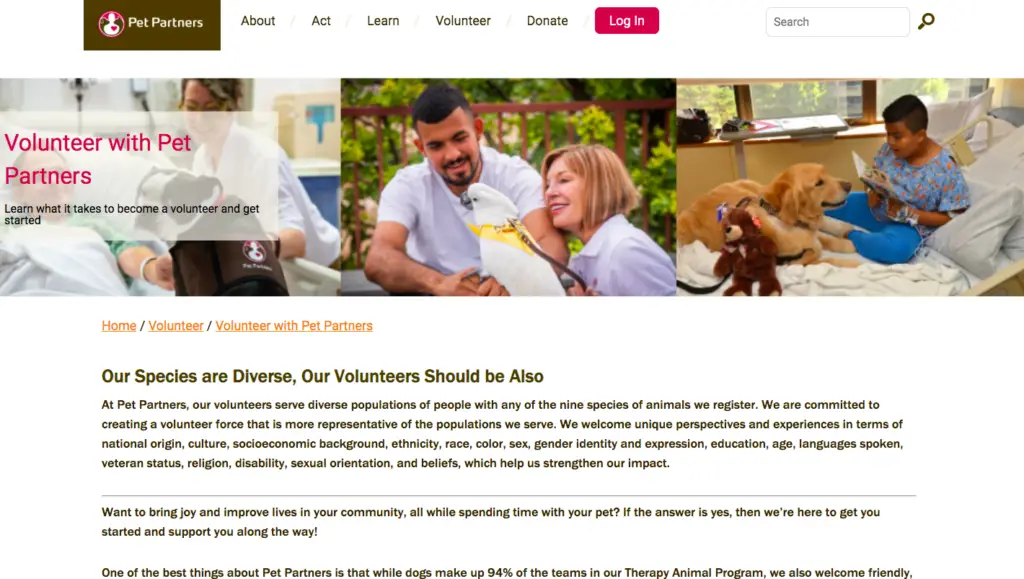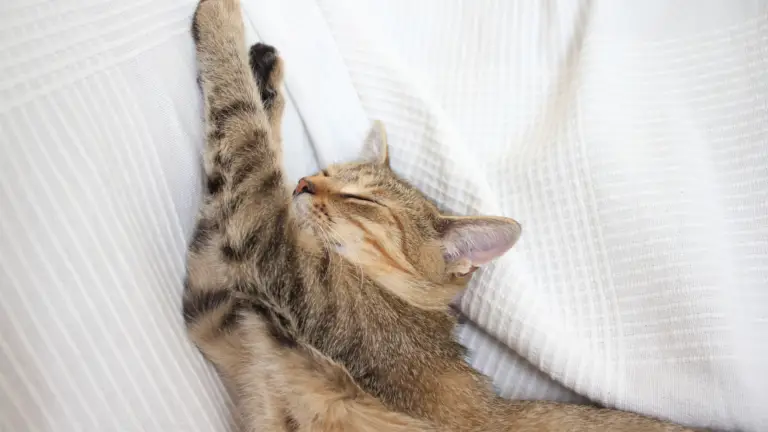HOW CAN MY CAT BECOME A THERAPY CAT? EASY GUIDE
How can my cat become a therapy cat? Does he even have the needed requirement or temperament to perform such function? We all know cats are challenging to train, their attention span is short, and unlike dogs, they do not follow directions easily. But can it still be done?
A cat can become a therapy cat by getting trained and certified by an authorized organization. A cat needs to meet the various requirements before enrolling in the program. The requirements vary depending on the organization that performs the training.
Let’s see step by step how to get your kitty to become a therapy cat.

WHAT IS REALLY A THERAPY CAT?
Over time, more and more pets are used as therapy pets. Typically dogs are famous for this kind of position. But over time, more and more pets have been added into the mix, including birds, rabbits, guinea pigs, donkeys, mini horses, rats, miniature pigs, llamas, and of course, cats.
Pet therapy is a supervised and guided interaction between a person and a trained pet, including the pet handler. The purpose of pet therapy is to help a person recover from a health situation or mental disorder.
The interaction with a cute, loving, and friendly pet has numerous advantages in reducing stress and help reduce the effects of many mental and physical problems. Pet therapy helps the body release endorphins, producing a calming effect that alleviates pain, lowers blood pressure, and improves mental conditions.
A therapy cat is trained to interact with people and help them to feel better. The interaction time is done under supervision.
Cat therapy sessions and pet therapy can be done to reach the following results:
- Improving joint movement and motor abilities
- Improving communication
- Improving social skills
- Creating a feeling of happiness
- Decrease depression
- Reduce anxiety
WHAT IS THE DIFFERENCE BETWEEN A THERAPY CAT AND A SERVICE DOG?
A service animal is a pet that is trained to do something for his owner. Service animals are defined under the Americans with Disabilities Act (ADA) to perform tasks and help people with disabilities.
For the moment, service animals are only dogs in the U.S. There aren’t any other animals recognized to be service pets besides miniature horses. It means that also cats cannot be service animals yet. Dogs are easy to train for the moment, and they make perfect service animals and therapy animals.
Cats are not yet there. Not too many people have the patients to train cats to perform tasks. It takes too long. But maybe in the future, we will see service cats too!
A therapy pet or cat is used to provide comfort and affection. They are not trained to perform tasks for people, but they are prepared to interact with people. They are used mainly in hospitals, schools, and hospice to provide emotional support.
A service animal can be with his owner at all times in public places, while a therapy cat or animal can enter public places with invitations only.
WHAT CATS BECOME THERAPY CATS?
Cats are famous for scaring easily, not liking to travel, and not make friends easily with new people. Cats who like to travel, like people, and are not afraid of changes are perfect therapy cats. Remember that therapy cats have to go to places and meet new people. Most probably, people and kids want to pet them, so they can’t be afraid of human contact and can’t be shy cats.
Therapy cats need to be friendly, calm, need to like people, changes, new environments, and very affectionate.
Not only a good therapy cat need to have the right temperament but need to have a strong bond with their handlers. As you can imagine, cats with such qualities are not that common, but not impossible.
What therapy cats do?
Therapy cats do not do much, really. They do not do tricks or extraordinary things. But, they come close to people, purrs, enjoy being pet, sit on people laps and let them scratch under the chin. Those things alone are very therapeutic for people in need of emotional support.
Treat your cat with a new house:










HOW CAN MY CAT BECOME A THERAPY CAT?
Providing you have a cat that is not afraid of people but actually likes meeting new friends and that your cat enjoys traveling and is not scared to move to new places, you may have a cat suited to be a therapy cat.
Besides, your cat has to be certified by an authorized organization, and each organization has its requirement. Therefore, you have to check with each organization their requirement to accept and train your cat.
To give an idea, the requirements can be:
- Cats need to be one year old
- Has to live with you for at least six months
- Be friendly with people and other pets
- Some require the cat to walk on a leash
- No raw diet
The steps to make your cat certified as therapy cat are the following:
- Make sure your cat has the right qualities to become a therapy cat
- Find a certified organization that can train and certify your cat
- Go through the training
- Get the certification
Let’s see what organizations are there that can train you and your cat.
BEST ORGANIZATIONS TO TRAIN AND CERTIFY YOUR CAT AS THERAPY CAT
Now we know what the basics personality needed from your cat to become a therapy cat is, we know what they do, and know that they need to train. So, where can you go to train your cat and get him certified?
Here are some of the best places to get your cat certified:

It is an organization that certifies various therapy animals, such as well-behaved cats, horses, birds, pigs, llamas & alpacas, rabbits, rats, dogs, and guinea pigs.
The requirements for cats are the following:
- Are at least one year old at the time of evaluation, pigs, and rats. Have a young animal?
- Have lived in the owner’s home for at least six months
- Must be reliably house trained
- Be currently vaccinated against rabies
- May not be fed a raw meat diet
- Have no history of aggression
- Demonstrate good basic obedience skills
- Welcome interactions with strangers.
The training received is mainly for the handler. You will have to take care of your cat training and teaching him everything.

This organization can certify cats, rabbits and dogs. The requirements are the following:
- The cat needs to be valuated by a veterinarian
- The cat must be able to ride in a car well and not stressed
- Must be well housetrained
- Must be able to wear a harness attached to a 4-ft leash
- Must be comfortable around dogs
- Must love people
They provide 10 training for you and your cat from a qualified team member.
3.PALS

This organization provides certifications for cats and dogs, they do not offer classes, but they can direct you to find places to get courses. They help you with the application and the evaluation to get certified.
Requirements are similar to the one mentioned above. Cats need to be litter trained, over one year, healthy and have an excellent temperament.
ADVANTAGES OF GETTING YOUR CAT CERTIFIED THERAPY CAT
Some people may want to have an emotional support cat at all times. If they are people in need or with disabilities, they can get a prescription from a certified ESA doctor. Emotional support pets are great to have around when a person is experiencing a lot of stress or other mental or physical disability.
Once you get approval from a medical doctor, you have to chose and train your future emotional support animal or train your own. A doctor will write an ESA letter that gives you the right to have your emotional support pet with you. This means you can bring him to hotels, in no pet-policy apartment, flys and other places.
Therapy cats are typically cats that belong to an owner if the owner wishes to volunteer and visit hospitals, and other institutions with people in need can do it through the organization described above.
In alternative, one can simply certify his own cat, and then practice as a volunteer, the cat is still belonging to the owner and not to the organization that trains him or certify him.
WHAT ARE THE BEST CAT BREEDS TO TRAIN AS THERAPY CAT?
85% of pet owners believe their pet helps reduce feelings of loneliness and isolation. Think about the fact that cats are low maintenance compared to dogs. They do not need to go out for walks and require little attention. But, at the same time, they are affectionate, intelligent, and funny.
Some breeds of cats are more suited to become therapy cats because they are intelligent, calm, like human contacts, and not afraid to be picked up and receive tons of affection. Those breeds are:
- Ragdoll
- American Bobtail
- Manx
- Persian
- Russian Blue
- Maine Coon
Ragdoll cats are known to be gentle, calm, and friendly. They are very devoted to their owners and seem to be able to connect emotionally with their owners. They are generally very friendly and affectionate. Thus if they are raised with a lot of affection and are trained early, this cat can be a perfect companion.
RELATED QUESTIONS
Here some related questions and answer:
- How do you qualify for an emotional support animal?
To qualify for an emotional support pet, you have to have a disability, and it has to be certified by a mental health doctor or a health care provider.
- Do cats make good therapy pets?
Cats can make good therapy pets for children, for people who need a gentle companion or cannot handle a dog. Some people also prefer to have cats and not dogs. Cats purr and have their funny and fluffy way to approach people.
- Are cats good for depression?
Cats are perfect for lowering depression, ease loneliness and encourage play. They can be goofy and funny and make people smile. Their purr is beneficial to people, and for children, a cat can be helpful because they can learn to care for another living being without having to do heavy care work.
Cats are easy to maintain. Even people with autism can get many benefits and learn how to be responsible for a pet.
CONCLUSION
I hope you could find all the answers regarding therapy cats, certify them, and the best breeds for emotional support cats. If you have more questions or want to add some things, leave them in the comments below.





![DO CATS RECOGNIZE THEMSELVES IN THE MIRROR? [NO… AND YES!]](https://dorkycats.com/wp-content/uploads/2020/09/cat-566648_1280-768x510.jpg)


Pawsome guide! Glad I popped by!
Thank you so much! Meow!
Always remember, a cat looks down on a man, a dog looks up to man, but a pig will look man right in the cat eye looking
and see his equal